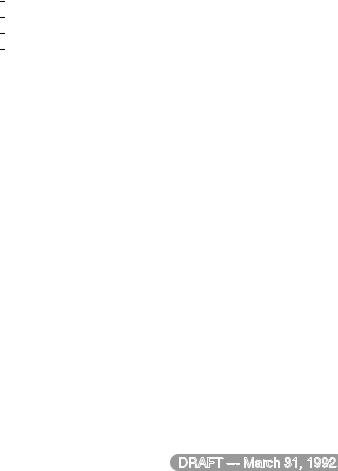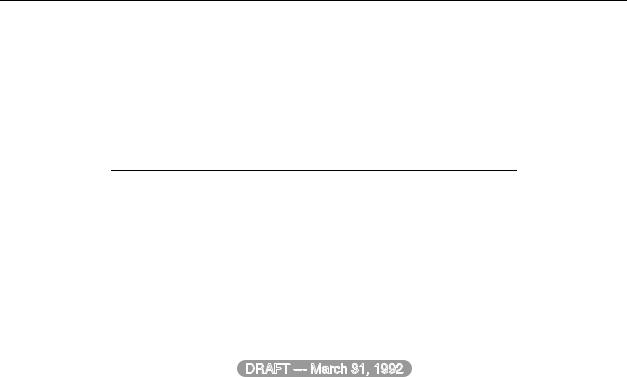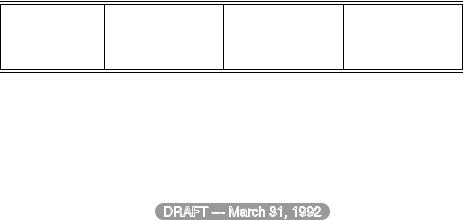
Barrett G.Occam 3 reference manual.1992
.pdf
P IEEE floating point arithmetic
REALOP and REALREM are implementations of the ANSI/IEEE 754-1985 floating point arithmetic standard. An implementation should comply to the requirements of the standard in as much as all results returned by them should be correct as defined in the standard. Most programmers will not need to use these functions directly as most occam implementations will compile all real arithmetic as calls to these functions. In some applications, such as interval arithmetic, the rounding modes are needed so the functions will need to be explicitly called in those cases. Also, in some applications, the IEEE standards use of infinities and Not-a- number to handle errors and overflows may be required in preference to the standard occam treatment of them as invalid expressions.
The functions for REAL32 operands are
REAL32 FUNCTION REAL32OP (VAL REAL32 X, VAL INT Op, VAL REAL32 Y)
...
:
REAL32 FUNCTION REAL32REM (VAL REAL32 X, VAL REAL32 Y)
...
: |
|
|
REAL32OP (X, Op, Y) evaluates |
according to the standard without error checking, using the |
|
conventional rounding mode. The various operations are coded in Op where: |
||
op = 0 |
+ |
|
= 1 |
- |
|
= 2 |
* |
|
= 3 |
/ |
|
REAL32REM (X, Y) evaluates REM according to the standard without error checking.
REAL64OP and REAL64REM are defined in an similar manner to operate on REAL64s.
IEEEOP (X, Rm, Op, Y) evaluates |
|
according to the standard without error checking. The |
||
rounding mode to be used is indicated by Rm where: |
||||
round mode |
= 0 |
Round to Zero |
|
|
round mode |
= 1 |
Round to Nearest |
|
|
round mode |
= 2 |
Round to Plus Infinity |
|
|
round mode |
= 3 |
Round to Minus Infinity |
||
The function is:
BOOL, REAL32 FUNCTION IEEE32OP (VAL REAL32 X,
VAL INT Rm, Op, VAL REAL32 Y)
...
:
BOOL, REAL64 FUNCTION IEEE64OP (VAL REAL64 X,
VAL INT Rm, Op, VAL REAL64 Y)
...
:
These functions return two results, a boolean which is true if an error has occurred, and false otherwise, and the result.
P.1 ANSI/IEEE real comparison
The comparisons on the real types provided in the occam language should suffice for most purposes. However, if the comparisons detailed in the ANSI/IEEE 754-1985 standard are required then they can be
DRAFT --- March 31, 1992

generated from the set of primitive comparisons.
BOOL FUNCTION REAL32EQ (VAL REAL32 X, Y) -- result = (X = Y) in the IEEE sense
...
:
BOOL FUNCTION REAL32GT (VAL REAL32 X, Y) -- result = (X > Y) in the IEEE sense
...
:
A standard function IEEECOMPARE will return a value which indicates which of the relations less than, greater than, equals or unordered as defined by IEEE 754 paragraph 5.7. This procedure is
INT FUNCTION IEEECOMPARE (VAL REAL32 X, Y) INT result :
VALOF
IF
ORDERED (X, Y) IF
REAL32EQ (X, Y) result := 0 REAL32GT (X, Y) result := 1
TRUE
result := -1
TRUE
result := 2 RESULT result
:
Then, if really necessary, any of the 26 varieties of comparison suggested by the IEEE standard can be derived. For instance the ? = predicate could be implemented by
BOOL, BOOL FUNCTION IEEE.UGE. (VAL REAL32 X,Y)
VAL LT IS -1, EQ IS 0, GT IS 1, UN IS 2: INT relation:
VALOF
relation := IEEECOMPARE (X, Y) RESULT FALSE,
(relation=GT) OR ((relation=EQ) OR (relation=UN))
:
Similarly ( ) could be implemented as
BOOL, BOOL FUNCTION IEEENOT.LG. (VAL REAL32 X,Y) VAL LT IS -1, EQ IS 0, GT IS 1, UN IS 2:
INT relation: VALOF
relation := IEEECOMPARE (X, Y)
RESULT (relation=UN), (relation=EQ) OR (relation=UN)
:
In either of these cases the value returned in the first boolean is equivalent to the invalid operation flag being set according to the ANSI/IEEE standard 754-1985.
The double length version DIEEECOMPARE is defined in a similar manner to IEEECOMPARE.
DRAFT --- March 31, 1992

Q Elementary function library
The elementary function library provides a set of routines which provide elementary functions compatible with the ANSI/IEEE standard 754-1985 for binary floating-point arithmetic.
All single length functions other than POWER, ATAN2 and RAN have one parameter which is a VAL REAL32 taking the argument of the function. POWER and ATAN2 have two parameters. They are both VAL REAL32s which receive the arguments of the function. RAN has a single parameter which is a VAL INT32. In each case the double-length version is obtained by prefixing a D onto the function name, whose parameters are
VAL REAL64 or, in the case of DRAN, VAL INT64.
Accompanying the description of each function is the specification of the function's Domain and Range. The Domain specifies the range of valid inputs, ie those for which the output is a normal or denormal floating-point number. The Range specifies the range of outputs produced by all arguments in the Domain. The given endpoints are not exceeded. Note that some of the domains specified are implementation dependent.
Ranges are given as intervals, using the convention that a square bracket [ or ] means that the adjacent endpoint is included in the range, whilst a round bracket ( or ) means that it is excluded. Endpoints are given to a few significant figures only. Where the range depends on the floating-point format, single-length is indicated with an S and double-length with a D.
For functions with two arguments the complete range of both arguments is given. This means that for each number in one range, there is at least one (though sometimes only one) number in the other range such that the pair of arguments is valid. Both ranges are shown, linked by an `x'.
In the specifications, XMAX is the largest representable floating-point number: in single-length it is approximately 3 4 1038, and in double-length it is approximately 1 8 10308. Pi means the closest floating-point representation of the transcendental number , ln(2) the closest representation of loge(2), and so on. In describing the algorithm, X is used generically to designate the argument, and “result” to designate the output.
The routines will accept any value, as specified by the IEEE standard, including special values representing NaNs (`Not a Number') and Infs (`Infinity'). NaNs are copied directly to the result, whilst Infs may or may not be valid arguments. Valid arguments are those for which the result is a normal (or denormalised) floating-point number.
Arguments outside the domain (apart from NaNs which are simply copied to the result) give rise to exceptional results, which may be NaN, +Inf, or Inf. Infs mean that the result is mathematically well-defined but too large to be represented in the floating-point format.
Error conditions are reported by means of three distinct NaNs :
undefined.NaN |
This means that the function is mathematically undefined for this argument, for |
|
example the logarithm of a negative number. |
unstable.NaN |
This means that a small change in the argument would cause a large change in the |
|
value of the function, so any error in the input will render the output meaningless. |
inexact.NaN |
This means that although the mathematical function is well-defined, its value is in |
|
range, and it is stable with respect to input errors at this argument, the limitations of |
|
word-length (and reasonable cost of the algorithm) make it impossible to compute |
|
the correct value. |
|
|
Implementations will return the following values for these Not-a-Numbers:
Error |
Single length value |
Double length value |
|
undefined.NaN |
#7F800010 |
#7FF00002 00000000 |
|
unstable.NaN |
#7F800008 |
#7FF00001 00000000 |
|
inexact.NaN |
#7F800004 |
#7FF00000 80000000 |
|
|
|
|
DRAFT --- March 31, 1992

In all cases, the function returns a NaN if given a NaN.
Q.1 Logarithm
REAL32 FUNCTION ALOG (VAL REAL32 X)
...
:
REAL64 FUNCTION DALOG (VAL REAL64 X)
...
:
These compute : result = loge(X).
Domain : |
(0, XMAX] |
|
|
|
|
Range : |
|
||||
[MinLog, MaxLog] = [ |
103 28 88 72] = [ |
745 2 709 78] |
|||
All arguments outside the domain generate an undefined.NaN.
Q.2 Base 10 logarithm
REAL32 FUNCTION ALOG10 (VAL REAL32 X)
...
:
REAL64 FUNCTION DALOG10 (VAL REAL64 X)
...
:
These compute : result = log10(X)
Domain : |
(0, XMAX] |
|
|
|
|
Range : |
|
||||
[MinLog10, MaxLog10] = [ |
44 85 38 53] = [ |
323 6 308 25] |
|||
All arguments outside the domain generate an undefined.NaN.
Q.3 Exponential
REAL32 FUNCTION EXP (VAL REAL32 X)
...
:
REAL64 FUNCTION DEXP (VAL REAL64 X)
...
: |
|
|
|
|
|
|
|
|
|
|
|
|
These compute : result = . |
|
|
|
|
|
|
|
|
|
|||
Domain : |
[ |
|
Inf, MaxLog) = [ |
|
|
88 72) = [ |
|
|
|
709 78) |
||
Range : |
|
|
|
|
|
|
|
|
||||
[0, XMAX) |
|
|
|
|
|
|||||||
If the result is too large to be represented in the floating-point format, Inf is returned.
DRAFT --- March 31, 1992

Q.4 X to the power of Y
REAL32 FUNCTION POWER (VAL REAL32 X, Y)
...
:
REAL64 FUNCTION DPOWER (VAL REAL64 X, Y)
...
:
These compute : result = .
Domain : |
[0, Inf] x [ |
|
Inf, Inf] |
||
Range : |
[ |
|
Inf, Inf] |
|
|
|
|
|
|
|
|
If the result is too large to be represented in the floating-point format, Inf is returned. If X or Y is NaN, NaN is returned. Other special cases are as follows :
First Input (X) |
|
Second Input (Y) |
Result |
|||||||
|
|
|
0 |
|
|
any |
|
undefined.NaN |
||
|
|
|
|
|
||||||
|
|
|
0 |
|
|
|
0 |
|
undefined.NaN |
|
|
|
|
0 |
|
|
|
0 XMAX |
0 |
||
|
|
|
0 |
|
|
|
Inf |
|
unstable.NaN |
|
|
0 |
|
|
|
1 |
|
Inf |
|
0 |
|
|
|
|
||||||||
|
0 |
|
|
|
1 |
|
XMAX |
Inf |
Inf |
|
|
|
1 |
|
|
|
XMAX |
1 |
|||
|
|
|
1 |
|
|
|
|
unstable.NaN |
||
|
|
|
|
|
|
Inf |
||||
1 |
|
|
XMAX |
|
Inf |
|
Inf |
|||
1 |
|
XMAX |
|
|
Inf |
0 |
||||
|
|
1 |
||||||||
|
|
|
Inf |
|
|
|
Inf |
Inf |
||
|
|
|
|
|
|
|
|
1 |
|
|
|
|
|
Inf |
|
|
|
Inf |
0 |
||
|
|
|
Inf |
|
|
|
1 |
|
1 |
undefined.NaN |
|
otherwise |
|
1 |
|||||||
|
|
|
0 |
|
||||||
|
otherwise |
|
|
1 |
|
|
||||
|
|
|
|
|
|
|
|
|
|
|
Q.5 Sine
REAL32 FUNCTION SIN (VAL REAL32 X)
...
:
REAL64 FUNCTION DSIN (VAL REAL64 X)
...
: |
|
|
|
|
|
|
|
|
|
|
|
|
|
|
These compute : result = sine(X) |
(where X is in radians). |
|
|
|
|
|
|
|
||||||
Domain : |
[ |
|
Smax, Smax] = [ |
|
12868 0 12868 0] = [ |
|
2 1 |
|
108 2 1 |
|
108 |
] |
||
Range : |
[ |
1.0, 1.0] |
|
|
|
|
|
|
|
|||||
|
|
|
|
|
|
|
||||||||
All arguments outside the domain generate an inexact.NaN. Implementations may provide a larger domain.
DRAFT --- March 31, 1992

Q.6 Cosine
REAL32 FUNCTION COS (VAL REAL32 X)
...
:
REAL64 FUNCTION DCOS (VAL REAL64 X)
...
: |
|
|
|
|
|
|
|
|
|
|
|
These compute : result = cosine(X) |
(where X is in radians). |
|
|
||||||||
Domain : |
[ |
|
Smax, Smax] = [ |
|
12868 0 |
12868 0] = [ |
|
2 1 |
108 2 1 |
108] |
|
Range : |
[ |
1.0, 1.0] |
|
|
|
|
|
|
|||
|
|
|
|
|
|
|
|
|
|||
All arguments outside the domain generate an inexact.NaN. Implementations may provide a larger domain.
Q.7 Tangent
REAL32 FUNCTION TAN (VAL REAL32 X)
...
:
REAL64 FUNCTION DTAN (VAL REAL64 X)
...
: |
|
|
|
|
|
|
|
|
|
|
|
|
|
|
These compute : result = tan(X) |
|
(where X is in radians). |
|
|
|
|
|
|||||||
Domain : |
[ |
|
Tmax, Tmax] = [ |
|
6434 0 6434 0] = [ |
|
1 05 |
|
108 1 05 |
|
108 |
] |
||
Range : |
|
|
|
|
|
|
|
|
|
|||||
( |
Inf, Inf) |
|
|
|
|
|
|
|||||||
All arguments outside the domain generate an inexact.NaN. Implementations may provide a larger domain.
Q.8 Arcsine
REAL32 FUNCTION ASIN (VAL REAL32 X)
...
:
REAL64 FUNCTION DASIN (VAL REAL64 X)
...
:
These compute : result = sine 1( ) (in radians).
Domain : |
[ |
1.0, 1.0] |
Range : |
[ |
Pi/2, Pi/2] |
|
|
|
All arguments outside the domain generate an undefined.NaN.
DRAFT --- March 31, 1992

Q.9 Arccosine
REAL32 FUNCTION ACOS (VAL REAL32 X)
...
:
REAL64 FUNCTION DACOS (VAL REAL64 X)
...
:
These compute : result = cosine 1( ) (in radians).
Domain : [ 1.0, 1.0]
Range : [0, Pi]
All arguments outside the domain generate an undefined.NaN.
Q.10 Arctangent
REAL32 FUNCTION ATAN (VAL REAL32 X)
...
:
REAL64 FUNCTION DATAN (VAL REAL64 X)
...
:
These compute : result = tan 1( ) (in radians).
Domain : |
[ |
Inf, Inf] |
Range : |
[ |
Pi/2, Pi/2] |
|
|
|
Q.11 Polar Angle
REAL32 FUNCTION ATAN2 (VAL REAL32 X, Y)
...
:
REAL64 FUNCTION DATAN2 (VAL REAL64 X, Y)
...
:
These compute the angular co-ordinate tan 1( ) (in radians) of a point whose X and Y co-ordinates are |
|||
given. |
|
|
|
Domain : |
[ Inf, Inf] x [ |
|
Inf, Inf] |
Range : |
( Pi, Pi] |
|
|
|
|
|
|
(0, 0) and ( |
Inf, Inf) give undefined.NaN. |
||
DRAFT --- March 31, 1992

Q.12 Hyperbolic sine
REAL32 FUNCTION SINH (VAL REAL32 X)
...
:
REAL64 FUNCTION DSINH (VAL REAL64 X)
...
:
These compute : result = sinh(X).
Domain : |
[ |
|
Hmax, Hmax] = [ |
|
89 4 |
89 4] = [ |
|
710 5 |
710 5] |
Range : |
|
|
|
|
|
|
|||
( |
Inf, Inf) |
|
|
|
|
|
|
||
Hmax gives Inf, and |
|
Hmax gives Inf. |
|
|
|||||
Q.13 Hyperbolic cosine
REAL32 FUNCTION COSH (VAL REAL32 X)
...
:
REAL64 FUNCTION DCOSH (VAL REAL64 X)
...
:
These compute: result = cosh(X).
Domain : |
[ Hmax, Hmax] = [ |
|
89 4 89 4] = [ |
|
710 5 710 5] |
|||
Range : |
[1.0, Inf) |
|
|
|
|
|
|
|
Hmax gives Inf.
Q.14 Hyperbolic tangent
REAL32 FUNCTION TANH (VAL REAL32 X)
...
:
REAL64 FUNCTION DTANH (VAL REAL64 X)
...
:
These compute : result = tanh(X).
Domain : |
[ Inf, Inf] |
Range : |
[ 1.0, 1.0] |
|
|
DRAFT --- March 31, 1992

Q.15 Pseudo-random numbers
REAL32, INT32 FUNCTION RAN (VAL INT32 N)
...
:
REAL64, INT64 FUNCTION DRAN (VAL INT64 N)
...
:
This function returns two results, the first is a real between 0.0 and 1.0, and the second is an integer. The integer, which must be used as the parameter in the next call to the function, carries a pseudo-random linear congruential sequence , and must be kept in scope for as long as the function is used. It should be initialised before the first call to the function but not modified thereafter except by the function itself. Consider the following sequence:
SEQ |
|
x, seed := RAN (8) |
-- initialise seed |
y, seed := RAN (seed) |
|
z, seed := RAN (seed) |
|
In this example x, y, and z are each assigned a pseudo-random value.
Domain : Integers
Range : [0.0, 1.0) x Integers
DRAFT --- March 31, 1992

R Value, string conversion routines
This appendix describes the standard library of string to value, value to string routines. The library provides primitive procedures to convert a value to and from decimal or hexadecimal representations. High input/output routines can be easily built using these simple procedures, and a number will typically be provided in an implementation.
R.1 Integer, string conversions
The procedures described here provide conversion between integer values and their decimal or hexadecimal representations held as a string of characters, for example:
PROC INTTOSTRING (INT len, []BYTE string, VAL INT n)
...
:
The procedure INTTOSTRING returns the decimal representation of n in string and the number of characters in the representation in len.
PROC STRINGTOINT (BOOL error, INT n, VAL []BYTE string)
...
:
The procedure STRINGTOINT returns in n the value represented by string. error is set to TRUE if a non numeric character is found in string. + or a - are allowed in the first character position. n will be the value of the the portion of string up to any illegal character with the convention that the value of an empty string is 0. error is also set if the value of string overflows the range of INT, in this case n will contain the low order bits of the binary representation of string. error is set to FALSE in all other cases.
PROC HEXTOSTRING (INT len, []BYTE string, VAL INT n)
...
:
The procedure HEXTOSTRING returns the hexadecimal representation of n in string and the number of characters in the representation in len. All the nibbles (a nibble is a word 4 bits wide) of n are output so that leading zeros are included. The number of characters will be the number of bits in an INT divided by 4.
PROC STRINGTOHEX (BOOL error, INT n, VAL []BYTE string)
...
:
The procedure STRINGTOHEX returns in n the value represented by the hexadecimal string. error is set to TRUE if a non hexadecimal character is found in string. Here n will be the value of the the portion of string up to the illegal character with the convention that the value of an empty string is 0. error is also set to TRUE if the value represented by string overflows the range of INT. In this case n will contain the low order bits of the binary representation of string. In all other cases error is set to FALSE.
Similar procedures are provided for the types INT16, INT32 and INT64. These procedures use equivalent parameters of the appropriate type. The procedures are:
INTTOSTRING INT16TOSTRING INT32TOSTRING INT64TOSTRING
STRINGTOINT STRINGTOINT16 STRINGTOINT32 STRINGTOINT64
HEXTOSTRING HEX16TOSTRING HEX32TOSTRING HEX64TOSTRING
STRINGTOHEX STRINGTOHEX16 STRINGTOHEX32 STRINGTOHEX64
DRAFT --- March 31, 1992
